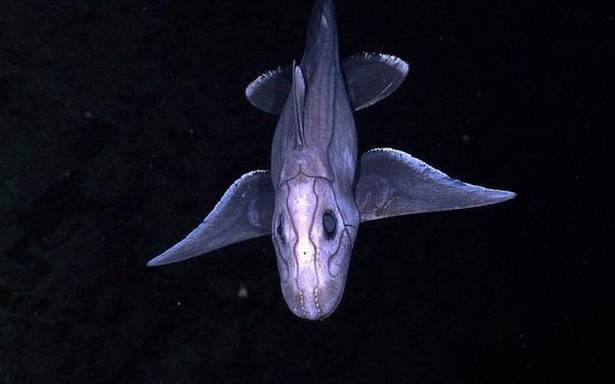Significant change recorded since the 2014 assessment of this group of marine fishes, note ZSI experts
A recent assessment of sharks, rays and chimaeras by the International Union for Conservation of Nature (IUCN)’s Shark Specialist Group in the Indian Exclusive Economic Zone (EEZ) has revealed that of the 170 species found across the oceans of the country, 19 (about 11%) are facing high risk of extinction.
“The new assessment of sharks rays and chimaeras point out that 11% of the 170 extant species of sharks, rays and chimaeras from Indian EEZ are classified as Critically Endangered (CE),” said K.K. Bineesh, scientist of the Zoological Survey of India (ZSI) and member of the IUCN Shark Specialist Group. Of the 19 species that have been assessed as critically endangered, there are seven species of sharks, five species of guitar fishes, two sawfishes, four wedge fishes and one species of stingray, the Maculabatis arabica, a recently discovered species.
Dr. Bineesh, who participated in the last IUCN global assessment of sharks and rays held at Canada in 2019, said that of the 170 species, another 30 are classified as Endangered (EN) as per the IUCN Red List for threatened species. He added that since the last assessment of this group of marine fishes, which was carried around 2014, there has been a significant change.
“In the last assessment, only 3% sharks, rays and chimaeras were Critically Endangered (CE), which increased to 11% in 2020. Similarly, for the Endangered (EN) category, the number of the species increased from 5% in 2014 to 18% in 2020,” Dr. Bineesh said.
This Red List update, which was made public a few days ago, marks for the first time one deep-water Indian swellshark Cephaloscyllium silasi as critically endangered due to very limited geographic range, and population decline. The Indian swellshark is a small deep-water catshark known from the coast of Kollam, Kerala and Sri Lanka, and also from the Andaman & Nicobar Islands. It occurs on the continental slope at depths of 100-500m. The species is caught as incidental catch by intensive deep-water trawl fisheries.
There are certain species like the Smooth hammerhead shark (Sphyrna lewini) and the Oceanic white-tip shark (Carchahinus longimanus), which were classified as endangered in an earlier assessment and are now listed as critically endangered because of a decline in their populations. Scientists behind the assessment in India have also expressed concern over the slow-growing dwarf gulper shark Centrophorus atromarginatus, which has high amounts of squalene in its liver and has been classified as critically endangered. Squalene is a natural organic compound found in shark liver oil and used in pharmaceutical industry.
The scientist also added that shark and rays numbers in Indian waters have fallen drastically in recent years due to target fishing (when a particular type of fish is targeted) and by-catch (other fish that get caught alongside). “Another challenge is that the information on deep-water species is very limited even in India, where we have a target catch of more about 1,000 tonnes annually to meet international export demand,” he added. About three decades ago, sharks were by-catch but now, there is target fishing of sharks, Dr. Bineesh explained.
The IUCN’s assessment of the remaining species of sharks, rays and chimaeras show that 38 of them are classified as Vulnerable (VU), 27 as Near Threatened (NT), 23 are of Least Concern (LC), 20 as Data Deficient (DD), and 13 as Not Evaluated.
“The IUCN assessment assumes significance not only because it is very difficult to study these species which are found in the deep seas but also because of the high economic value around such marine resources. Each species of shark, rays and chimaeras are crucial to the blue economy of the country,” Kailash Chandra, Director of ZSI, said.
Dr. Chandra called for the need for more accurate species-specific data for formulating a shark conservation policy to rebuild depleted shark populations for the benefit of the ecosystem and also the people that depend on them for livelihoods and food security.
This article is auto-generated by Algorithm Source: www.thehindu.com


